JAY BOOSH
I haven’t been playing for very long. Somebody explain to me what the big deal with [Grim Lavamancer] is.
SCOTTY MAC
Free damage, ridiculously cheap.
JAY BOOSH
It’s not free damage. You have to pay mana and tap it.
SCOTTY MAC
Yeah, but it’s like Shock on a stick, dude.
. . . .
SCOTTY MAC
The other thing too is, don’t forget, once the Scars block becomes the meat and potatoes, everything’s two [toughness].
MARSHALL SUTCLIFFE
Basically, it’s awesome. It can kill [Jace, the Mind Sculptor]. And this thing comes down [and] the main decks that run it will fill up a graveyard. Either they cast dudes and those dudes beat you down. If you take care of the dudes, then this thing is sitting there. Most people don’t wanna use removal on it and it’s a one-drop, so it can get under almost all the counters.
The Eh Team podcast, episode 41 “Summer Camp”
In the summer of 2011, Wizards previewed the reprint of Grim Lavamancer for Magic 2012. During its first trip through Standard, during Odyssey block, the card was a powerhouse and the promise of it returning to Standard had many players very excited. The card never really did much in the Standard it was reprinted into, as Innistrad block gave the world Geist of Saint Traft, Olivia Voldaren, and Huntmaster of the Fells, all of which generated huge amounts of value while proving to be hard to combat in many respects. From my perspective, all the hype was built upon what people remembered Grim Lavamancer being a decade earlier and the hope that it would be that again.
Card evaluation is hard. Often people look at a card and always imagine the best case scenario where their game plan will never be counter acted. But unfortunately many cards, even greats like Baneslayer Angel, can dramatically shift in power level as the landscape of new cards come into a format. In a non-rotating format like Commander it can be even harder. You want to believe that a new card is going to outclass a card you’ve tolerated in your deck, or that your most-loved pet card won’t be outclassed. As Ravnica Allegiance enters the format, I wanted to spend today talking about the pros and cons of card evaluation, especially when I was very right or very wrong.
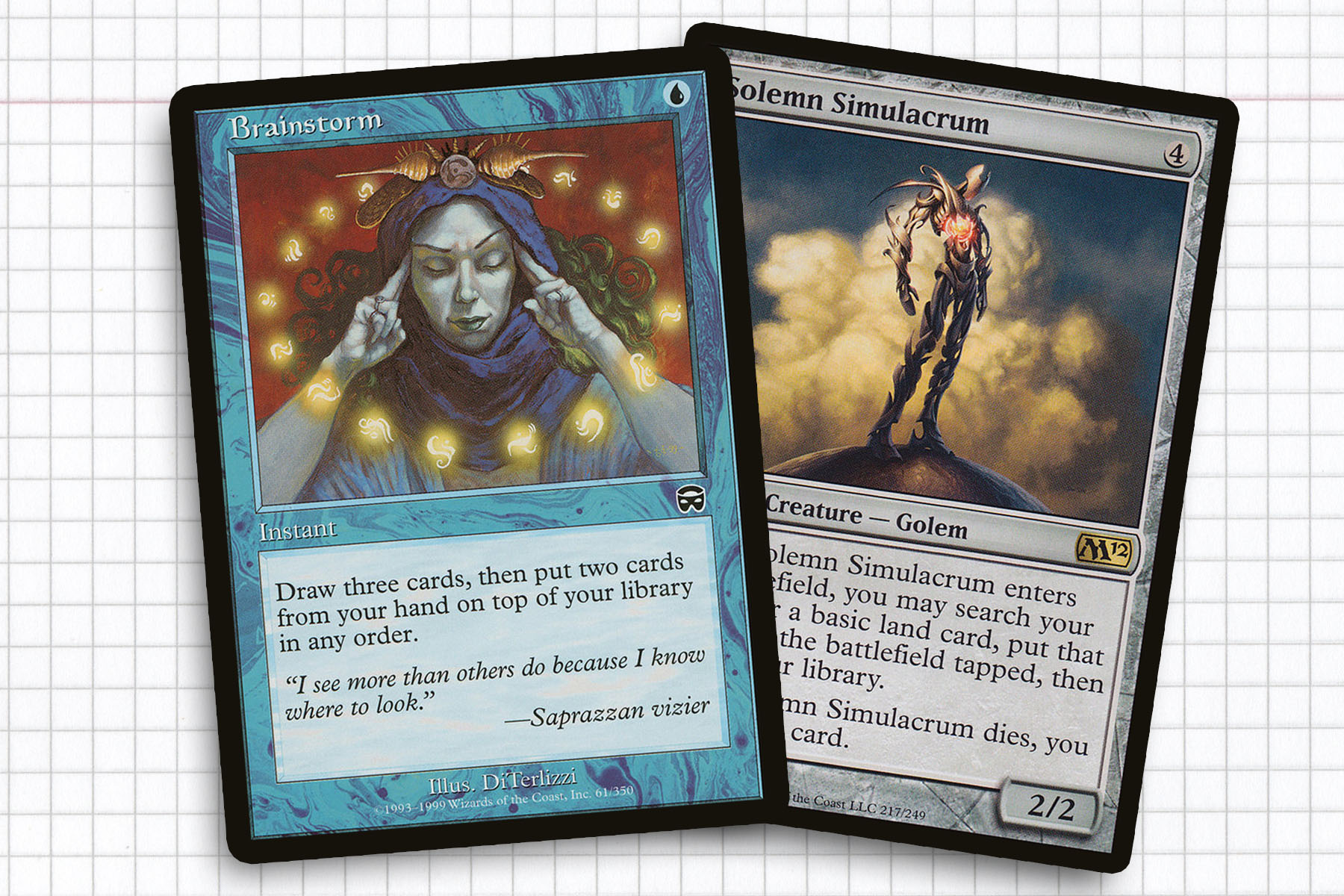
Brainstorm and Solemn Simulacrum
It’s funny how the legacy of a card can outweigh its value in many cases. When I first started playing Commander, I remember buying Strip Mine for my Ib Halfheart, Goblin Tactician deck and feeling a sense of accomplishment. I had always heard about the card and it just felt cool to have it in a deck. In hindsight, the card isn’t bad at all; but it’s not something I personally consider a threat when it hits the table.
Similarly, in all of my time playing Magic, Brainstorm has been talked about in hushed tones. I recall interviews on Evan Erwin’s The Magic Show with Patrick Chapin where they gushed how essential it was to older formats. So imagine my surprise when I finally bought copies of Brainstorm for my Commander decks only to discover that the card really isn’t that good. And I think this goes back to the idea that most people, myself included, don’t know how to play Brainstorm properly at first. Contextually it does you no good on turn one and is more akin to a powered-up Opt—useful when you need to find an answer to a threat as soon as possible.
Then we have Solemn Simulacrum, a card that is undoubtedly a Commander staple. This card evaded inclusion in my decks for far too long. I wouldn’t even blame it on trying to be too much of an “EDH hipster” and avoiding all the popular cards; I just never really cared to slot it into a deck and test it out for myself. Solemn Simulacrum represents three cards, and the true synergistic potential of the card had always gone over my head because the value can be so subtle when accrued over multiple turns. Where I would have played cards like Wood Elves or Armillary Sphere in the past, I now consider the Simulacrum.
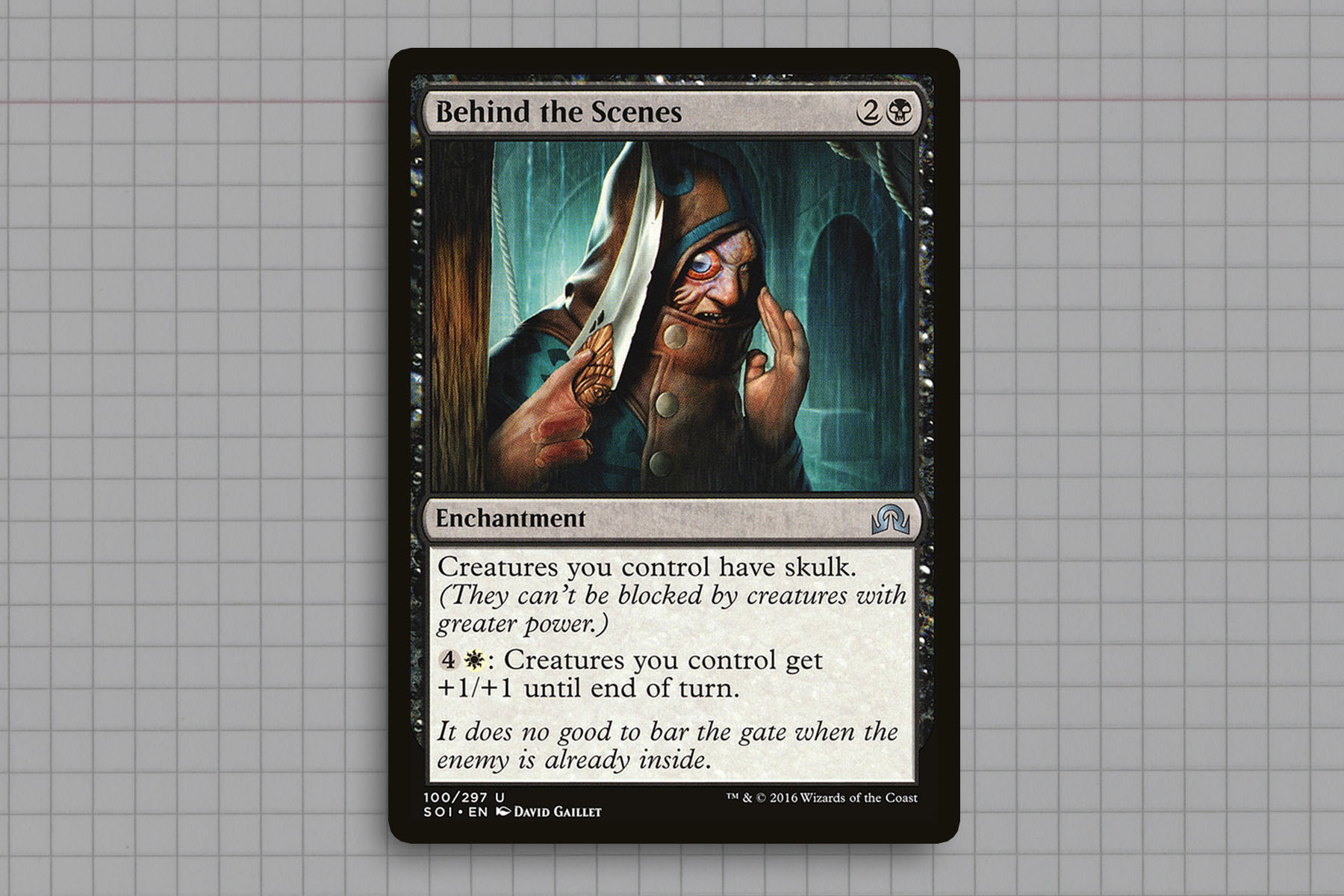
Behind the Scenes
Lordy Lord, did I want Behind the Scenes to be an all-star in my Doran, the Siege Tower deck. With the deck in question, so many of the creatures have a higher toughness than power. So by extension, it seemed entirely possible that Behind the Scenes would be a perfect fit for the deck, punishing my opponents for having bulky creatures synonymous with the format. The card did in fact make some of the combat math difficult for the rest of the table, but casting it never cleared a path to victory for me.
What I learned was that a card that could be a game-changer was actually counterintuitive to what I wanted to do. Because the deck plays enchantments or equipment that grant power boosts along with trample or lifelink, suddenly Behind the Scenes was granting skulk to a creature that had a fairly high power of three or four because it was holding a Loxodon Warhammer. At three or four power, a lot of things could suddenly block my Rhox Faithmender or Blood Artist, negating the purpose of adding it to the deck.
I wanted this card to be good. After nearly a year-and-a-half of having it in my deck, I finally realized that it was never as good as I wanted it to be. For the most part I would add a card to a deck if it made my chances of winning improve. But with Behind the Scenes, it actually just made tracking board states more complicated for me and lessened my enjoyment of one of my favorite decks.
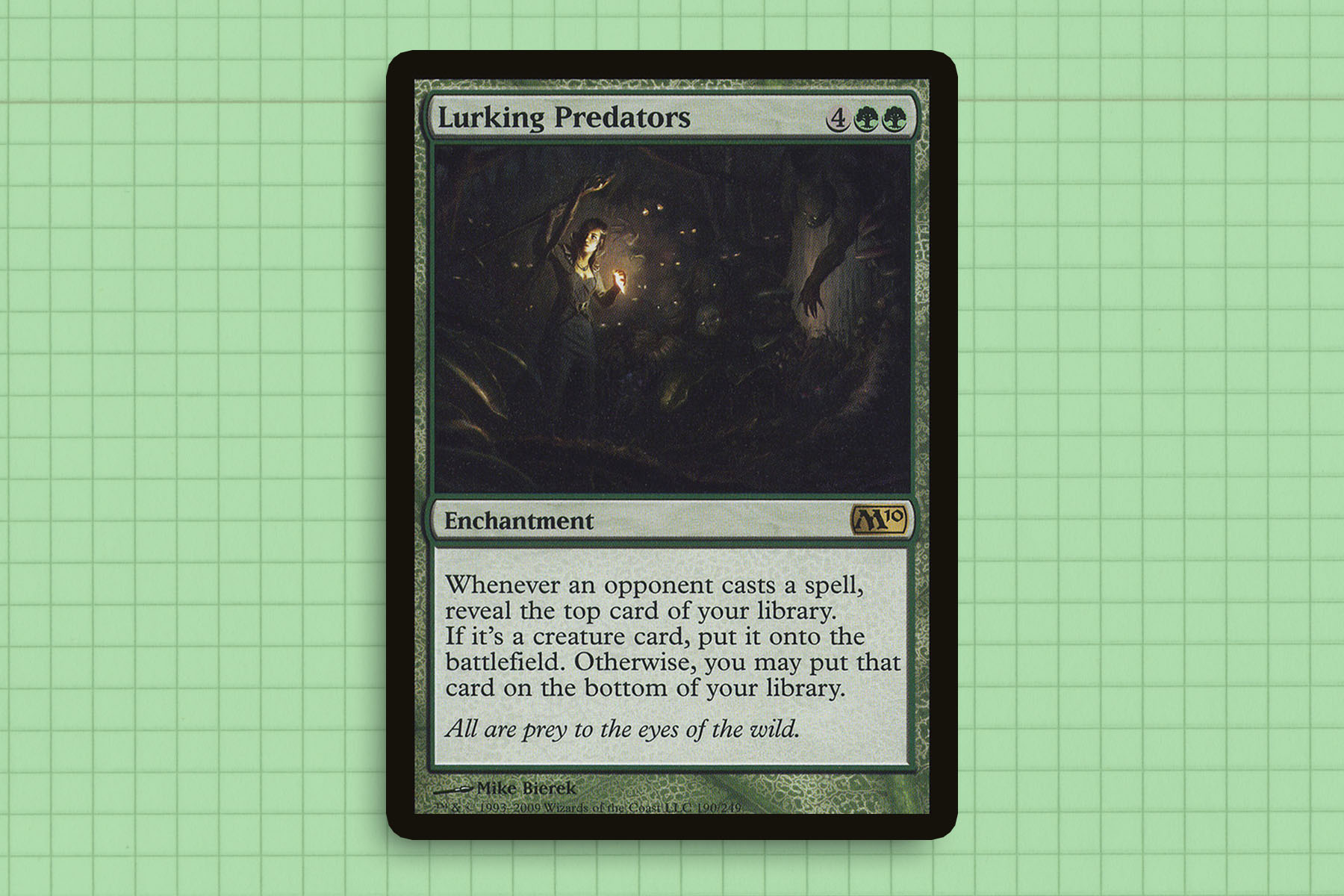
Lurking Predators
I am easily turned off by perceived “do nothing” enchantments. In the case of Lurking Predators, I looked at it and didn’t see the potential because it didn’t feel like it was the kind of card that was going to garner me enough power for the main investment. Man was I wrong. In all fairness, this card needs the right kind of deck. You need many creatures that mostly impact the board at any time, which is not something that you necessarily get with your Loaming Shaman or Cloudchaser Eagle.
It wasn’t until I had built and tuned my Shattergang Brothers Eldrazi deck that I took a hard look at Lurking Predators. During one run through of the deck, I had discovered a card wasn’t doing so hot and opted to find a replacement. I remember stumbling upon Lurking Predators and having the same preconceived notions I mentioned before, “this card doesn’t do anything.” But I remembered it being in a casual deck a friend had played from years earlier where it acted like a green Standstill and thought that if nothing else, it might play similarly here.
The casual friends group metagame and Commander groups can play differently. And in this case Lurking Predators was never a deterrent to somebody playing their spells. It was however a good way for me to cheat out my creatures in the face of unafraid opponents. This card often cheats in upwards of three creatures before I untap with it in play. For the mana investment, it’s always better than Kindred Summons and I love that card. The lesson here is that you don’t know what a card is really going to do until you play with it. Perceived notions can be ill-advised.
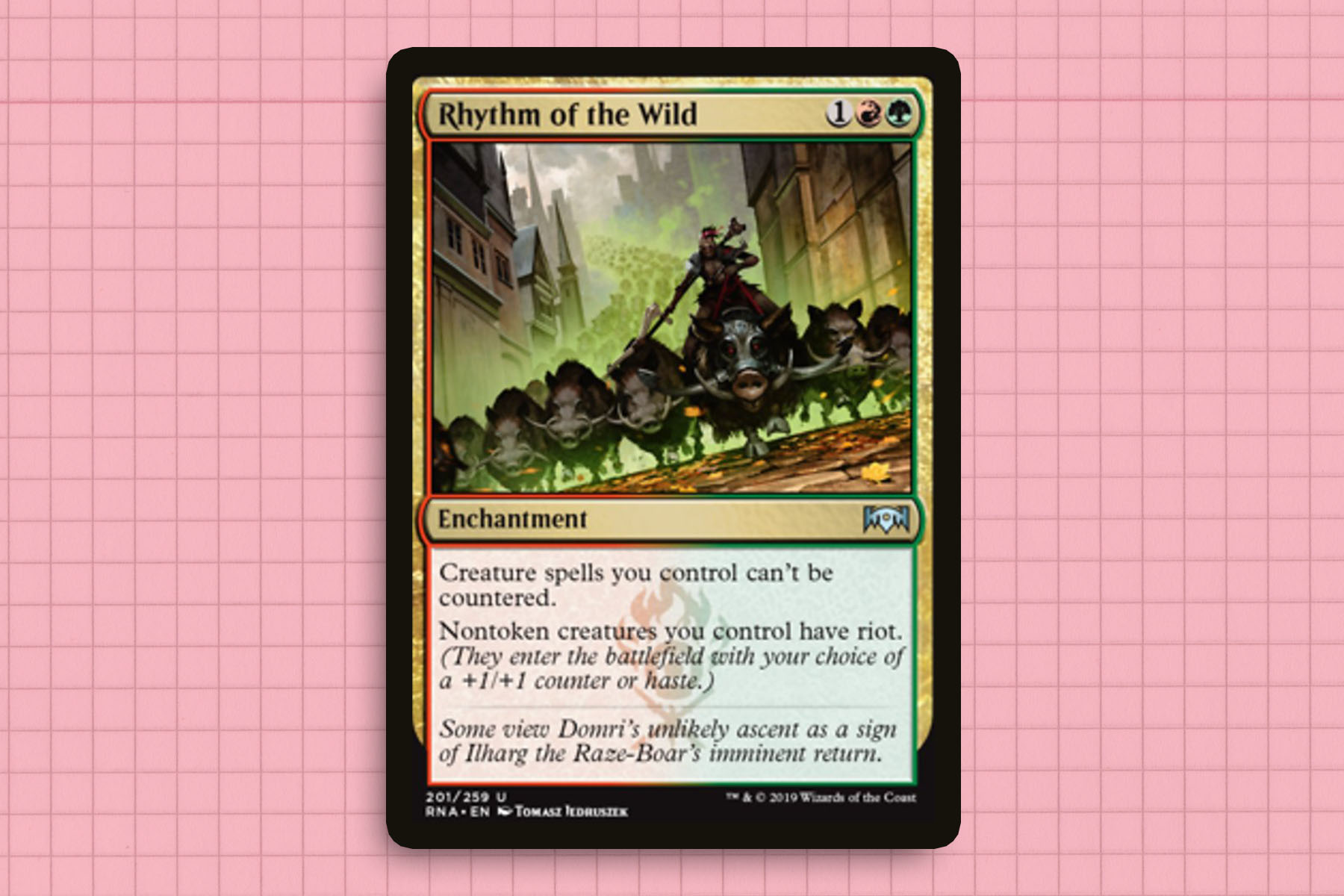
Rhythm of the Wild
I try not to let confirmation bias drive my entire experience, but this was the most anticipated card of Ravnica Allegiance for me and it has totally paid off every time I have cast it thus far. It stood out as a candidate for my Shattergang Brothers Eldrazi deck, which I know very well.
For quite a while I have been unhappy with Gruul War Plow. It had made its way into the deck as a colorless permanent, dodging All is Dust while supplying my team with trample, but often the four mana investment wasn’t really worth it. I was never happy to draw it late in the game, because strangely, the Eldrazi I typically had in play weren’t going to benefit from trample anyway. But granting riot seems remarkably different, allowing my creatures to dodge counter magic, while providing haste for a surprise attack to close out the game. And the best feeling has been casting Reality Smasher, making it a little bit bigger, which in turn made my Eldrazi Mimic that much bigger.
Rhythm of the Wild was always going to be a roleplayer, and early results say that it will fit my needs very well. This is also a good example of knowing a flaw in your deck and seeking a solid replacement. I’m impressed enough with Rhythm that I am considering it for other decks, like Yasova Dragonclaw or The Ur-Dragon where haste is already attached to a lot of my creatures and I will benefit from the +1/+1 counter.
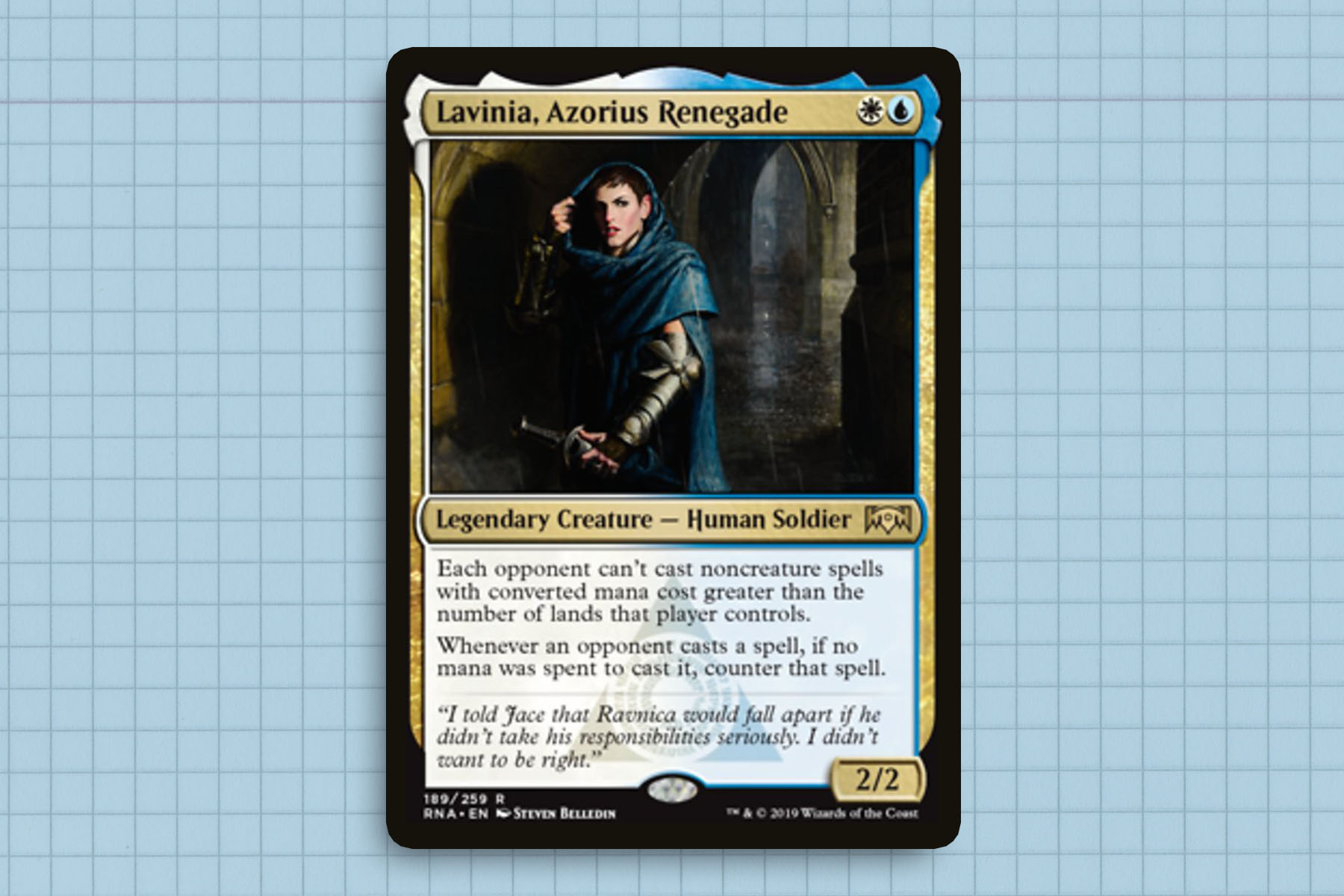
Lavinia, Azorius Renegade
As has been documented in the past, I am not somebody that normally looks at a card and sees the most broken potential. I often look for the fun, trying to figure out what wacky thing can be done, completely disregarding just how degenerate another player might make a card. This is why I completely underrated Edgar Markov. But when I looked at Lavinia, Azorius Renegade for the first time, all I saw was something that screamed unfun. At the core of my fears is the comparison to Gaddock Teeg, which may not be a fair comparison. Both decks are limiting what players can do, but Lavinia is not outright preventing the game from continuing against opponents who are playing “fairly.”
Time will tell with this one, because at the time of writing the lists I have seen others propose are not entirely degenerate. And I do have to wonder if, intentionally or not, this card will act as a safety valve in metagames where spells are being cast through infinite mana engines and/or methods of cheating out spells through cascade. She plays well with cards like Guile, Lullmage Mentor, and Armageddon—not my favorite cards, but they have purpose in this deck. Maybe she’s not a problem, but I will have my sights set on her if I ever see her at the helm of a deck.
I don’t know that I have a central thesis to how to correctly evaluate cards for Commander. But in my eyes the biggest lesson I can take away from all of this is that playing with cards is often the easiest way to figure out if they are doing what you personally want to be doing. The best cards played by the best players are not always going to garner fun, which is a factor in Commander. I don’t want to play a two-hour game that’s mathematically perfect; I want to have fun.
As always audience experiences will vary. What what is a card that you have looked at and either been right or wrong in your evaluations? And what cards really surprised with how much fun they generated? I look forward to any feedback and I will see you next week.
Ryan Sainio is a Graphic Designer who writes about EDH, the EDH community, and streams on Twitch in his down time. He has been playing Magic: The Gathering since 7th Edition in 2002 and values flavorful and fun gameplay over competitively optimized decks. Join him for a stream at twitch.tv/hipstersainio on Tuesday nights.

